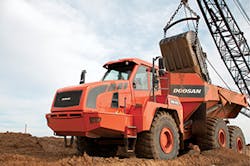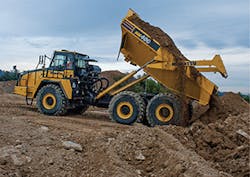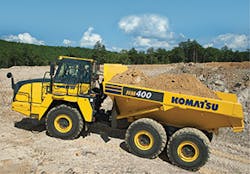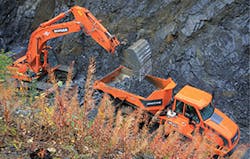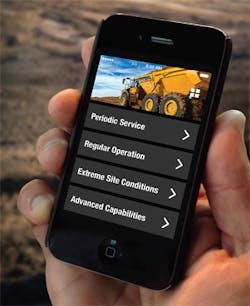Editor’s Note: This article first appeared in the June 2016 issue of Grading & Excavation Contractor.
There are two types of wheeled off-road dump trucks: rigid and articulated. The technology incorporated into each is very similar. They both followed recent tech trends by adding operator enhancements and they all meet EPA Tier 4 Final/EU Stage IV emission standards, notes Kresten Binder, executive vice president for Hydrema US. “They basically have the same technology,” he says.
“Both articulated and rigid dump trucks do utilize similar technology, such as payload monitoring systems, telematics, and automatic retarders,” adds Joe Sollitt, product marketing manager, haul trucks and motor graders, for Komatsu America Corp.
The technology is similar from an operational standpoint, states Maryanne Graves, product marketing manager, articulated dump trucks (ADTs), for John Deere Construction and Forestry. Both offer remote monitoring, traction control, downhill speed control, collision warning and, in mining, a birds-eye view. In addition, she says, there’s “not a lot of price difference at the lower end.”
Everyone agrees that where the differences come in is on the job site. “It’s all about the application,” insists Binder, adding that other considerations such as size, loading equipment, the amount of material to be moved, and especially job-site conditions, also factor into the decision.
But, Graves says, “Job site and the job are the most important in making a decision. The amount of materials is secondary.”
Conditionally Speaking
The choice is highly dependent on the application. “Essentially, ground conditions most often dictate whether articulated trucks or rigid trucks are appropriate for a given job site,” summarizes Sollitt. Applications in which conditions are less than ideal call for articulated dump trucks, he says. These includeslippery grounds, tight switchbacks, and low ceiling heights.
Although he asserts that ADTs “work in any condition,” Ewen Gilchrist, sales and marketing for ADTs at Doosan, says that a few conditions for which ADTs are suited are wet, soft, and slippery; places with restricted turning radiuses; and narrow roads.
And he adds to the list: “Wet, muddy, sandy. [Also] soft or wet underfoot conditions, steep slopes, short hauls….”
The ADT’s six-wheel-drive and wider tires provide more flotation that enables it to maneuver sub-par conditions. Its suspension allows it to negotiate uneven terrain.
Hauling with a Doosan DA40
“Unless you have a good haul road that’s hard-packed, an ADT is better,” says Binder. “It is capable if you have wet [conditions], uneven roads, or difficult terrain, because the ADTs are lighter and the tires are wider, which helps spread out the load. They pretty much go anywhere.”
He explains that the Hydrema ADTs have low ground pressure, so there is less ground disturbance, making them particularly adapted to small site development where it’s difficult or cost-prohibitive to make haul roads.
Because ADTs have better maneuverability, they are well suited to small sites. Articulated steering improves mobility in confined areas where a smaller turning radius is an issue. “There’s more use of ADTs on smaller sites or anywhere that’s too soft for standard trucks, or if the site has slopes,” says Binder.
One reason ADTs work so well in poor underfoot conditions is that they are designed to keep all six wheels in contact with the surface. Scott Thomas, senior product application specialist for Caterpillar, explains that the design of the oscillating and articulating hitch allows the truck to work in extreme conditions. Thanks to this six-wheel drive, the articulated truck can work on grades up to 35%, rolling resistances of 20%, and loaded haul distances from 500–10,000 feet.
Doosan’s ADTs feature a tandem bogie function that helps keep tires in continuous contact with the surface for improved traction, stability, and safety. The oscillating bogie allows the tires to stay on the ground at all times, contributing to stability and traction.
Because the tandem bogie features only one differential on the back end, it also saves costs and maintenance and helps reduce operator-related damage, says Gilchrist. It allows 25 degrees of oscillation up and 15 degrees down.
Another way the Doosan ADTs enhance traction and reduce maintenance costs is with a sloping (not horizontal) rear frame that brings weight forward and distributes it on all six tires. Forward-mounted turning axles equalize the drive on left and right tires, evenly distributing weight and wear. “It provides better wear and traction,” explains Gilchrist. “Traction is unlike any other truck on the market.”
Another way the Doosan is different from other trucks is in the number of drive axles. Doosan has only two, as opposed to the more common three-drive axles. “It’s unique,” states Gilchrist. “We’re the only one who offers that.” One less drive axle means less maintenance.
A Komatsu HM400 empties its load
Traction is particularly important in soft ground conditions. Optimized weight distribution and a driven front axle increase traction while reducing frame stress. All of Komatsu America’s articulated trucks feature the Komatsu Traction Control System, which automatically provides optimum traction when operating.
The system continuously monitors driveshaft speeds, explains Sollitt. As ground conditions worsen, if the system detects tire slippage on the middle or rear axle, it will automatically engage the inter-axle clutch to provide power to all three axles. The system then monitors wheel speeds. If wheel slippage is detected, it will modulate the wet disc brake pack on the slipping wheel to reduce tire slippage and transfer power to the tires that require it. This results in reduced fuel consumption, longer tire life, and better turning performance, while providing optimal traction in poor ground conditions.
The A-frame suspension and hydro-pneumatic struts on the front and rear axles of the Komatsu ADT contribute to faster cycle times on rough terrain, as well as less material spillage. The suspension design, along with the viscous cab mounts, provides a comfortable ride for the operator, regardless of ground conditions.
Moving dirt with a Komatsu HM400
Location, Location, Location
It’s those rugged ground conditions that make ADTs so useful, but their adaptability contributes to their popularity on other jobs. Historically, scrapers were used on many of these difficult jobs—and are still in use on some jobs today—but the ADT has increasingly become a popular choice of machinery.
Although the majority of mining applications still use rigid trucks, ADTs are being seen more often. In addition to overburden removal at mines and quarries, Sollitt says they are ideal for road building, site preparation, reclamation projects, and transporting fly ash at coal-burning power generation facilities. “Versatility is what makes these trucks so popular.”
And the list goes on. Thomas says articulated trucks are used on greenfield sites as well as for subdivision construction, detention ponds, highway projects, and hydroelectric dams. He points out that they were used to build canals (Suez and Panama expansions).
ADTs are a good choice on “any kind of job where you plan to move a certain amount of dirt,” says Hydrema’s Binder, from small site development to massive excavation jobs. But, he concludes, “you can’t make a rigid [truck] efficient on a small job, and you won’t use small ADTs on a big job. That’s not changing.”
The Long Haul
“On job sites where well-maintained haul roads exist, rigid trucks tend to be a more ideal fit,” says Sollitt. “Hard-packed, well-maintained roads are best suited for rigid frame trucks.”
And they’re perfect for applications at surface mines or large sand, gravel, or rock quarries, he explains. “Since these types of applications are usually longer term, it allows time for roads to be established and maintained,” he adds.
Because they are heavy rear-wheel drive trucks, they typically perform better on hard-packed, well-maintained, well-drained haul roads, emphasizes Caterpillar’s Thomas. “Rigid frame trucks work best on grades of 10 to 15% or less.”
They’re the best choice for applications with few roads and long travel distances, when a large volume of materials is involved or quick load times are required, when hard ground and a long, flat, maintained road is available, says Gilchrist. Those conditions and requirements are typically found in mining, quarry, and road building applications. “That’s where you see a long haul on flat roads at high speed,” he says.
Look at the application: If it involves a massive amount of material and requires fast cycle times, it’s likely that you’ll want a rigid frame truck with a larger hauling capacity. These rear-wheel-drive trucks are capable of longer hauling distances at higher speeds that put too much wear and tear on an ADT, explains Graves.
The Payout on Payload
As Sollitt mentions, rigid dump trucks are used on jobs when increased payloads, faster travel speeds equating to faster roundtrip travel times, and reduced owning and operating costs are critical. “The key advantage rigid trucks have over arctic trucks is carrying capacity,” he says.
Komatsu America’s mechanical trucks haul between 40 and 158.9 tons, where as their articulated trucks have capacities of 30.9–44.1 tons. The capacity of Komatsu’s electric drive, rigid dump trucks ranges from 200–360 tons.
Articulated trucks are limited on payload when compared with rigid frame trucks, elaborates Thomas. Caterpillar offers trucks from 40–400 tons. The choice “really depends on the material, length of the project, haul road conditions, loading tool, and how much production a customer is looking to achieve on a daily basis.” He says that most rigid trucks are put to work on a long-term project (longer than five years) where the increased payload helps to achieve the daily production requirements of the customer.
In addition to providing larger payload capacity than articulated trucks, Komatsu’s rigid trucks have a tight turning radius that makes them maneuverable in constricted work areas. “This is made possible by the MacPherson strut front suspension design that pulls the front tire away from the mainframe,” explains Sollitt. This suspension design also provides a comfortable ride for the operator, in addition to a wide, stable stance, resulting in a higher steering angle.
But, while rigid frame trucks have been known for their payload for years, Thomas says Caterpillar’s ADTs are catching up. “Rated payload capacities for the new models are 36, 42, and 45.2 tons, with
all models replacing their B Series predecessors. The new 745C’s 1.7-ton capacity increase—compared with the 740B’s capacity—combines with its faster cycle times for significant production gains.”
To keep track of that payload, Komatsu articulated dump trucks come standard with a payload management system. The system is fully integrated into KOMTRAX, Komatsu’s telematics system, so daily production reports can be monitored from any computer with Internet access or the user’s handheld device.
Cat’s Connect Payload technologies for the 735C, 740C EJ, and 745C offer Cat Production Measurement as an option. This allows operators to measure and deliver accurate payloads to boost productivity, lower costs, and prevent the potential for overload damage. When used with Cat Connect LINK technologies, data can be accessed through an online user interface, enabling customers to assess performance and productivity data and make timely decisions about their fleet.
Common Ground
A Doosan DA30 takes on a load
Some of Deere’s competitors are developing larger ADTs, acknowledges Graves. “There’s a 50-ton on the market now, and a 60-ton in development,” she says. “They still won’t get the capacity of a rigid. Capacity will max out; they won’t get to 100 tons.”
The industry is shifting to larger trucks, she continues. Deere’s largest ADT is the 460E, introduced in June 2015 and featuring a transmission retarder to help the operator maneuver on steep declines in mines and quarries. “For large earthmoving jobs, you want maneuverability. A 46-ton is a big deal.” It’s already one of their popular machines, along with the 370E and 410E.
Deere is also coming out with new, smaller trucks this year—the 260E and 310E—but even those will offer increased capacity over earlier small models.
“There is some overlap [in application] between the ADT and the rigid,” concedes Gilchrist, depending on travel distance, grade, terrain, and weather.
Once the specific machine has been chosen, tires are a major factor. “When it comes to ADTs, there are three choices: earthmoving, rock [with more rubber to protect the sidewall], and flotation, which are wider,” says Gilchrist. It’s important to select the right tire for the application, but often, the choice depends on budget and availability.
Wide base tires with an 80% profile give articulated trucks more traction, better terrain mobility, and low ground pressure. E3 tires are designed for earthmoving applications, while E4 tires are designed for abrasive, rocky situations such as quarries and mines.
Tires aside, Gilchrist recognizes that changes are coming in the ADT versus rigid battle. “Some of our competitors are making a bigger ADT to compete with rigid trucks by working in all conditions and on all roads.”
John Deere’s GoHaul mobile app
Technological Development
Size isn’t the only advancement in dump trucks. New technology continues to be incorporated on these behemoths. “Now that the entire lineup of articulated trucks is Tier 4 Final,” observes Caterpillar’s Thomas, “we can concentrate more on fuel efficiency and operator comfort and safety.”
For Deere, that includes an updated cab that is sealed and pressurized to keep out dust and noise, thereby allowing the operator to concentrate on the work. Creature comforts include push-button start; low-effort push-button controls; air-suspension heated high-back seats; tilt/telescoping steering wheels; and optional premium stereo with Bluetooth, auxiliary input, and satellite radio capability. Stairway lights can be turned on with the push of a button from ground level for easier visibility when entering the larger cab entryway.
Today’s technology is all about simplicity of operation. “The least experienced operators get put on the most expensive machines, so make it easy to operate,” suggests Gilchrist. The Doosan cab is designed to be simple to use, incorporating features like telematics and load scales.
Features that contribute to ease of operation—and overall efficiency—on Cat models include the hill assist system, which facilitates stopping and starting on grades, and the waiting brake system, which temporarily applies the service brakes during pauses in the work cycle, whether they are from waiting at the loading or dumping site or delays from site congestion.
Retarding control for Caterpillar’s C Series models can now be set to fully automatic, reducing necessary operator input. In addition, the automatic traction control feature adjusts as the machine encounters changing terrain and underfoot conditions while the machine is moving without operator intervention. The system maintains optimum traction, saves fuel by applying the locks based on operating conditions, and does not hinder tight-maneuver steering.
Komatsu takes automation a step further; their rigid dump trucks can be operated unmanned. They can be controlled instead through a computer, vehicle controllers, GPS, an obstacle detection system, and a wireless network.
John Deere’s auto dump feature allows the operator to stay in the truck, points out Graves. The new 370E, 410E, and 460E articulated dump trucks have cabs equipped with updated 7-inch, high-resolution LCD monitors for easy access to onboard diagnostics, digital gauges, and vital system indicators, all of which are located within arm’s reach.
JD Link, Deere’s proprietary and exclusive telematics solution, offers work site integration through remote technology. An onboard weighing system provides real-time load and tonnage data, explains Graves, while the remote diagnostics program can lower operating costs and a remote alert can avert hefty repairs and downtime.
Operators aren’t the only ones enjoying technological improvements. Deere’s E-series machines are equipped with ground-level grease and fluid ports for convenience, safety, and ease of maintenance. All daily service can be completed from the ground. For dusty environments, there is a reversible fan option available for simplified cooler cleanout.
On the cutting edge of technology designed for today’s generation, the GoHaul mobile app by John Deere Construction for E-series ADT customers is a good reference for operators, allowing instant access to information about the machine, including a walk-around checklist for daily service items, a guide to better understanding unique features, and tips to maximize productivity.
Technology also addresses efficiency, productivity, and costs. For example, the recent Cat 735C, 740C EJ, and 745C articulated trucks offer new transmissions with expanded electronic control, automatic traction control, automatic retarder control, as well as optional payload weighing systems. These improvements should help lower costs per ton by reducing cycle times, saving fuel, and easing the operator’s work load.
Similarly, all Komatsu rigid trucks feature an advanced, electronic transmission control system. Sollitt explains that the Komatsu advanced transmission with optimum modulation control system chooses the optimum gear automatically for any given angle of ascent and reduces the number of downshifts with its “skip-shift” functionality to increase operator comfort, increase powertrain durability, and reduce required road maintenance. The operator can set the desired speed while traveling down grade; the system then automatically modulates the wet, multi-disc brakes on the rear axle to maintain that desired travel speed.
The new 740C EJ ejector model, which combines the 745C’s tractor with a horizontal-discharge body, can unload material to uniform depths while traveling at speed. In addition to discharging the load with added stability in soft underfoot conditions, on side slopes and grades, and in environments where overhead obstructions are present, it may reduce the need for additional onsite spreading equipment.
For all the technological progress these trucks have made, Gilchrist points out that basics like serviceability and dealer and OEM support may be more important than ever. Considering the price point of these machines, which Binder estimates can reach as high as $8 million, uptime is crucial, whether it’s an articulated dump doing small site development in muddy conditions or a rigid frame truck making long hauls out of a quarry.
